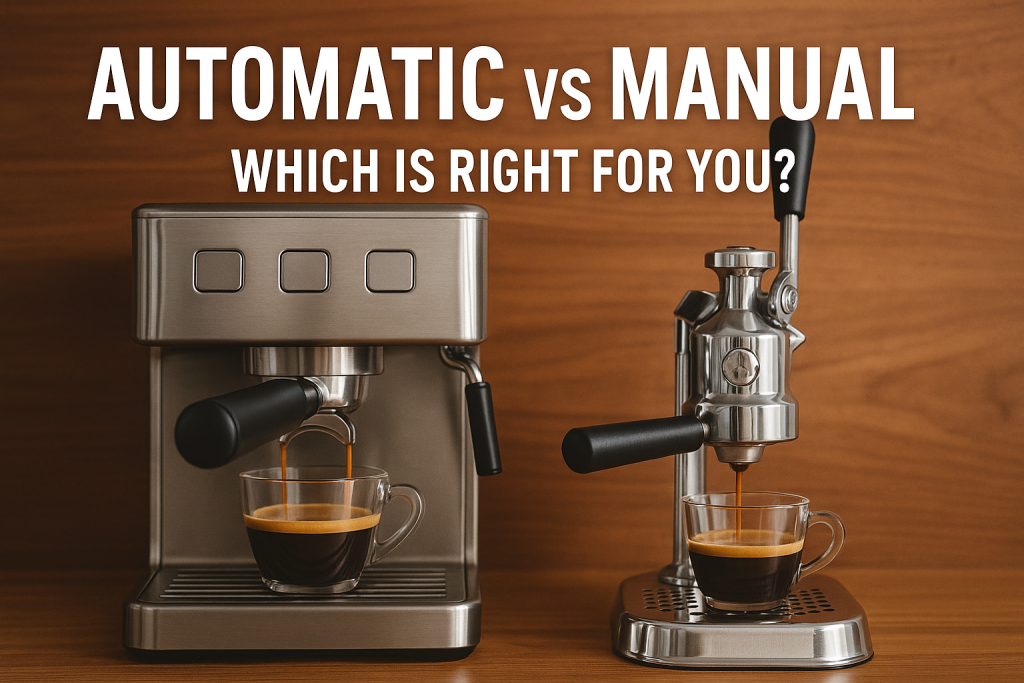
If you’re ready to start brewing espresso at home or for your business, choosing the right type of machine is one of the most important decisions you’ll make. The most common options are automatic and manual espresso machines, each offering different levels of control, consistency, and skill required.
In this guide, we’ll break down the pros and cons of automatic vs. manual espresso machines, explore their price ranges, and help you decide which one fits your lifestyle and coffee goals best.
🤖 What Is an Automatic Espresso Machine?
An automatic espresso machine (also known as a volumetric machine) uses programmed settings to control the water flow for extracting espresso. You press a button, and the machine dispenses a pre-measured amount of water through the coffee puck.
Types of Automatic Machines:
- Semi-Automatic: User controls grind and tamping, starts and stops the shot manually
- Automatic (Volumetric): Machine automatically stops the shot after preset volume
- Super-Automatic: Fully automated — grinds, tamps, brews, and often self-cleans
Pros of Automatic Espresso Machines:
- Consistency: Delivers uniform results every time
- Speed: Quicker brew process, ideal for high-volume settings
- Ease of Use: Great for beginners or staff with minimal training
- Less Room for Error: Pre-programmed settings reduce user mistakes
Cons of Automatic Espresso Machines:
- Limited Control: Less flexibility for dialing in your shot
- Expensive Repairs: More complex internal components
- Less Craft Involvement: May not satisfy coffee purists
Price Range:
- Semi-Automatic: $300 – $1,200 (home use)
- Automatic/Volumetric: $1,000 – $8,000 (home or small commercial)
- Super-Automatic: $1,500 – $20,000+ (office, hotel, high-volume café)
💪 What Is a Manual Espresso Machine?
A manual espresso machine, often called a lever machine, requires the user to control every part of the brewing process — including water pressure, shot timing, and volume. These machines are loved for their artistry and the hands-on brewing experience they provide.
Types of Manual Machines:
- Spring Lever: Uses an internal spring to create consistent pressure when pulled
- Direct Lever: Pressure is entirely user-controlled
Pros of Manual Espresso Machines:
- Full Control: You adjust pressure, timing, and volume to match your coffee profile
- Artisan Craftsmanship: The most rewarding experience for coffee purists
- Beautiful Design: Often have vintage or elegant aesthetics that impress
- Durability: Fewer electronic parts mean less maintenance risk
Cons of Manual Espresso Machines:
- Steep Learning Curve: Requires time and skill to master
- Inconsistent Results: Until you’re experienced, results may vary
- Slower Brew Time: Not ideal for busy mornings or commercial settings
Price Range:
- Entry-Level Lever Machines: $400 – $900
- Premium Lever Machines: $1,000 – $6,000+
🆚 Automatic vs. Manual: Which One Should You Choose?
Choosing between automatic and manual espresso machines depends on your preferences, experience level, and how much time and control you want over the brewing process.
Ask yourself:
- Do I want consistent results or room to experiment?
- Am I brewing for myself or for guests/customers?
- Do I enjoy the ritual and craft of pulling a shot?
- Do I want speed and convenience?
📊 Comparison Table
| Feature | Automatic Espresso Machines | Manual Espresso Machines |
|---|---|---|
| Ease of Use | High | Low |
| Learning Curve | Minimal | Steep |
| Control Over Brewing | Limited to Moderate | Full |
| Brew Time | Fast (under 1 minute) | Moderate (2–4 minutes) |
| Maintenance | More frequent, technical repairs | Simple, fewer parts |
| Customization | Limited by presets | Fully customizable |
| Price Range | $300 – $20,000+ | $400 – $6,000+ |
| Aesthetic Appeal | Modern, sleek | Vintage, artisan look |
| Ideal For | Beginners, offices, high-volume | Hobbyists, enthusiasts, purists |
✅ Final Thoughts
If you’re looking for convenience, speed, and consistency, an automatic espresso machine is the way to go. It’s perfect for busy kitchens, offices, or anyone new to espresso who wants café-quality drinks at home.
On the other hand, if you love the hands-on process, value tradition, and enjoy the ritual of coffee preparation, a manual espresso machine delivers a rewarding and artistic brewing experience.
There’s no wrong choice—only what fits best with your brewing style, time, and passion for espresso.
Head back to our Coffee & Espresso Buying Guides
